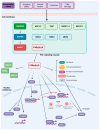Metastasis and MAPK Pathways
- PMID: 35409206
- PMCID: PMC8998814
- DOI: 10.3390/ijms23073847
Metastasis and MAPK Pathways
Abstract
Cancer is a leading cause of death worldwide. In many cases, the treatment of the disease is limited due to the metastasis of cells to distant locations of the body through the blood and lymphatic drainage. Most of the anticancer therapeutic options focus mainly on the inhibition of tumor cell growth or the induction of cell death, and do not consider the molecular basis of metastasis. The aim of this work is to provide a comprehensive review focusing on cancer metastasis and the mitogen-activated protein kinase (MAPK) pathway (ERK/JNK/P38 signaling) as a crucial modulator of this process.
Keywords: c-JUN N-terminal kinase (JNK); cancer; extracellular signal-regulated kinase (ERK); metastasis; mitogen-activated kinases (MAPKs).
Conflict of interest statement
The authors declare no conflict of interest.
Figures





Similar articles
-
Galloyl benzamide-based compounds modulating tumour necrosis factor α-stimulated c-Jun N-terminal kinase and p38 mitogen-activated protein kinase signalling pathways.J Pharm Pharmacol. 2015 Oct;67(10):1380-92. doi: 10.1111/jphp.12438. Epub 2015 Jun 16. J Pharm Pharmacol. 2015. PMID: 26078032
-
Cell-specific activation profile of extracellular signal-regulated kinase 1/2, Jun N-terminal kinase, and p38 mitogen-activated protein kinases in asthmatic airways.J Allergy Clin Immunol. 2008 Apr;121(4):893-902.e2. doi: 10.1016/j.jaci.2008.02.004. J Allergy Clin Immunol. 2008. PMID: 18395552
-
Stress-activated kinase pathway alteration is a frequent event in bladder cancer.Urol Oncol. 2012 Jul-Aug;30(4):415-20. doi: 10.1016/j.urolonc.2010.03.002. Epub 2011 Dec 11. Urol Oncol. 2012. PMID: 22154358
-
[MAPK signaling pathway and erectile dysfunction].Zhonghua Nan Ke Xue. 2018 May;24(5):442-446. Zhonghua Nan Ke Xue. 2018. PMID: 30171761 Review. Chinese.
-
Mitogen-activated protein kinase pathways mediated by ERK, JNK, and p38 protein kinases.Science. 2002 Dec 6;298(5600):1911-2. doi: 10.1126/science.1072682. Science. 2002. PMID: 12471242 Review.
Cited by
-
Antimigratory Effect of Lipophilic Cations Derived from Gallic and Gentisic Acid and Synergistic Effect with 5-Fluorouracil on Metastatic Colorectal Cancer Cells: A New Synthesis Route.Cancers (Basel). 2024 Aug 27;16(17):2980. doi: 10.3390/cancers16172980. Cancers (Basel). 2024. PMID: 39272835 Free PMC article.
-
Metamorphic Effect of Angiogenic Switch in Tumor Development: Conundrum of Tumor Angiogenesis Toward Progression and Metastatic Potential.Biomedicines. 2023 Jul 29;11(8):2142. doi: 10.3390/biomedicines11082142. Biomedicines. 2023. PMID: 37626639 Free PMC article. Review.
-
Synthesis of Zinc Oxide-Doped Carbon Dots for Treatment of Triple-Negative Breast Cancer.Int J Nanomedicine. 2024 Dec 27;19:13949-13971. doi: 10.2147/IJN.S494262. eCollection 2024. Int J Nanomedicine. 2024. PMID: 39742095 Free PMC article.
-
Helicobacter pylori-induced fibroblast-derived Serpin E1 promotes gastric cancer growth and peritoneal dissemination through p38 MAPK/VEGFA-mediated angiogenesis.Cancer Cell Int. 2023 Dec 16;23(1):326. doi: 10.1186/s12935-023-03177-1. Cancer Cell Int. 2023. PMID: 38104099 Free PMC article.
-
A disintegrin and metalloprotease 12 contributes to colorectal cancer metastasis by regulating epithelial‑mesenchymal transition.Int J Oncol. 2023 Apr;62(4):50. doi: 10.3892/ijo.2023.5498. Epub 2023 Mar 3. Int J Oncol. 2023. PMID: 36866761 Free PMC article.
References
-
- Eyles J., Puaux A.-L., Wang X., Toh B., Prakash C., Hong M., Tan T.G., Zheng L., Ong L.C., Jin Y., et al. Tumor cells disseminate early, but immunosurveillance limits metastatic outgrowth, in a mouse model of melanoma. J. Clin. Investig. 2010;120:2030–2039. doi: 10.1172/JCI42002. - DOI - PMC - PubMed
Publication types
MeSH terms
Substances
LinkOut - more resources
Full Text Sources
Medical
Research Materials
Miscellaneous

